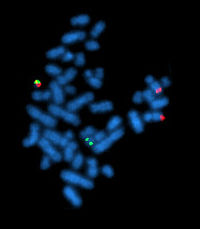
Photo from wikipedia
Chronic myeloid leukaemia (CML) is driven by the activity of the BCR–ABL1 fusion oncoprotein. ABL1 kinase inhibitors have improved the clinical outcomes for patients with CML, with over 80% of… Click to show full abstract
Chronic myeloid leukaemia (CML) is driven by the activity of the BCR–ABL1 fusion oncoprotein. ABL1 kinase inhibitors have improved the clinical outcomes for patients with CML, with over 80% of patients treated with imatinib surviving for more than 10 years. Second-generation ABL1 kinase inhibitors induce more potent molecular responses in both previously untreated and imatinib-resistant patients with CML. Studies in patients with chronic-phase CML have shown that around 50% of patients who achieve and maintain undetectable BCR–ABL1 transcript levels for at least 2 years remain disease-free after the withdrawal of treatment. Here we characterize ABL001 (asciminib), a potent and selective allosteric ABL1 inhibitor that is undergoing clinical development testing in patients with CML and Philadelphia chromosome-positive (Ph+) acute lymphoblastic leukaemia. In contrast to catalytic-site ABL1 kinase inhibitors, ABL001 binds to the myristoyl pocket of ABL1 and induces the formation of an inactive kinase conformation. ABL001 and second-generation catalytic inhibitors have similar cellular potencies but distinct patterns of resistance mutations, with genetic barcoding studies revealing pre-existing clonal populations with no shared resistance between ABL001 and the catalytic inhibitor nilotinib. Consistent with this profile, acquired resistance was observed with single-agent therapy in mice; however, the combination of ABL001 and nilotinib led to complete disease control and eradicated CML xenograft tumours without recurrence after the cessation of treatment.